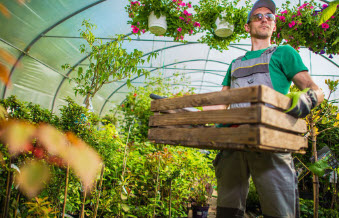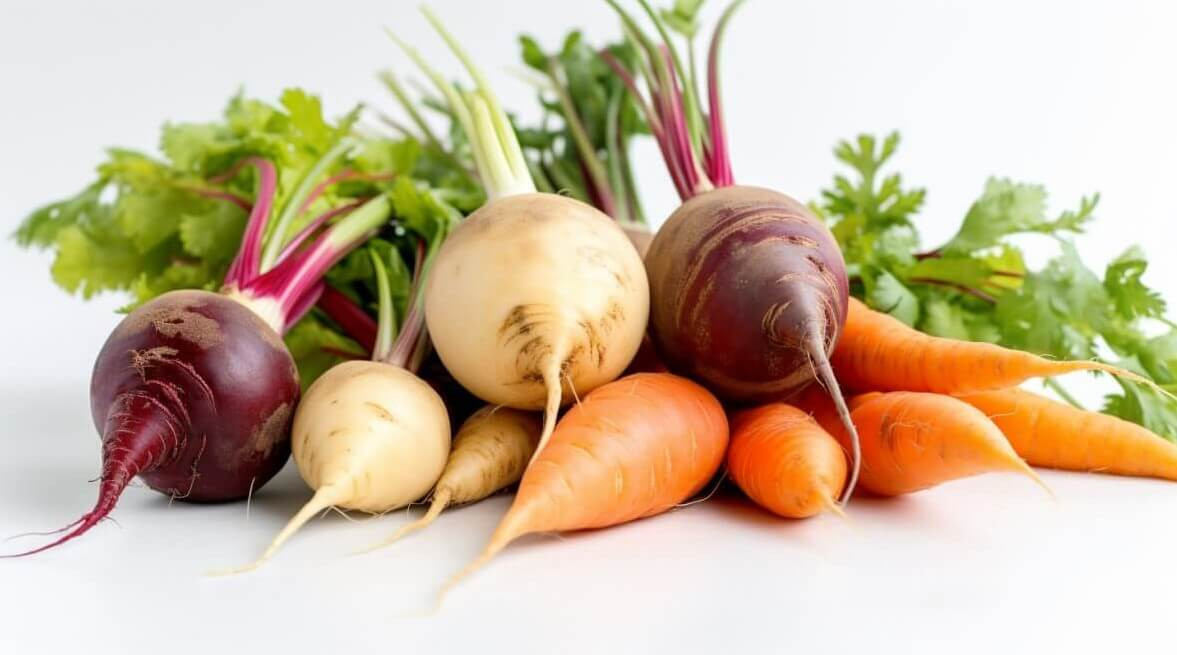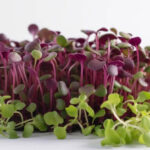Would you prefer to listen to a short podcast discussion about this article? Click on the audio below.
Growing root vegetables can be a rewarding experience for gardeners of all levels. Root vegetables are versatile, nutritious, and can be harvested throughout the year. However, to get the most out of your root vegetable garden, there are several factors to consider, including the type of vegetables to grow, soil preparation, planting techniques, and care during growth.
In this article, we will provide a comprehensive guide on how to grow root vegetables, covering everything from selecting the right vegetables to maximizing yield and flavour. Whether you’re a seasoned gardener or a beginner, this guide will equip you with the knowledge and skills needed to grow a bountiful crop of root vegetables.
Table of Contents
Types of Root Veg to Grow
Root vegetables are a staple in the UK and can be easily grown in your own garden. Here are some popular and uncommon root vegetables to consider growing:
Popular Root Vegetables
Carrots, swedes, turnips, parsnips and beetroots are some of the most popular root vegetables in the UK. These vegetables are easy to grow and can be used in a variety of dishes, making them a great addition to any garden.
Uncommon Root Veg to Consider Growing
If you’re looking to try something new, consider growing turnips, parsnips, or rutabagas. These vegetables are less commonly found in grocery stores but are just as delicious and can add some variety to your meals.
Preparing the Soil for Root Veg
Growing healthy root vegetables starts with proper soil preparation. Here are some tips on getting your soil ready for planting:
Suitable Soil Types
Root vegetables prefer loose, well-draining soil that is rich in organic matter. Sandy loam and loamy soils are ideal for root vegetable growth.
Testing and Amending Soil for Optimal Growth
Before planting, test your soil pH to ensure it falls between 6.0 and 7.5. If the pH is off, adjust it by adding lime to raise the pH or sulfur to lower it. Additionally, adding compost or aged manure can help improve soil quality and nutrition for root vegetables.
Planting Root Veg
When it comes to planting root vegetables, timing and method are key. Here are some tips to ensure success:
Choosing the Right Time to Plant
Most root vegetables are planted in early spring or late summer for an Autumn harvest. However, some, like carrots, can be planted throughout the growing season. Check your seed packet for specific planting times.
Direct Seeding vs. Transplanting
Root veg can be direct seeded into the ground or started indoors and then transplanted. Direct seeding is easier but takes longer to produce a harvest while transplanting can lead to quicker results but requires more effort.
Caring for Root Veg as They Grow
Root vegetables require regular care to ensure they grow healthy and strong. Here are some tips for caring for your plants:
Watering and Fertilizing
Water your plants regularly, making sure the soil stays moist but not waterlogged. Additionally, providing a balanced fertilizer can help promote root growth and overall plant health.
Thinning and Mulching
As the vegetables grow, they may need to be thinned to allow for proper growth. Mulching can also help retain moisture and regulate soil temperature, leading to healthier plants. Use a thin layer of organic materials, like straw or shredded leaves, around your plants to keep them healthy.
Harvesting Root Vegetables
Growing your own root vegetables can be a rewarding experience, but knowing when and how to harvest them can be a bit tricky. Root vegetables are typically ready to harvest when they have reached their full size, but it’s important to check for other signs of maturity as well.
Signs That Your Crop is Ready to Harvest
There are a few indicators that root veg is ready to be harvested. First, check to see if the foliage has died back or turned yellow. This is a good sign that the plant has stopped growing and is ready to be harvested. You can also gently dig around the base of the plant to check the size of the root. If it’s the desired size, it’s time to harvest.
Harvesting Techniques for Different Types of Root Vegetables
Different types of root veg require different harvesting techniques. For example, carrots can be gently pulled out of the ground by the foliage, while parsnips require a garden fork to loosen the soil around the root before pulling. Beetroot can be harvested by gently twisting the tops and lifting the root out of the soil. It’s important to be gentle to avoid damaging the vegetables.
Storing Root Veg After Harvest
After harvesting your root vegetables, it’s important to store them properly to ensure they last as long as possible.
Proper Storage Conditions for Different Root Veg
Different root vegetables require different storage conditions. Some vegetables, like carrots and parsnips, prefer cool and dry conditions, while others, like beetroot and turnips, prefer moist conditions. It’s important to research the ideal storage conditions for each type of root vegetable to ensure they last as long as possible.
Recommended Storage Containers for Root Veg
Root vegetables can be stored in a variety of containers, including wooden crates, mesh bags, and plastic bins. Whatever container you choose, make sure it allows for good air circulation to prevent rotting. It’s also important to keep different types of vegetables separate to prevent moisture transfer and spoilage.
Common Pests and Diseases
Unfortunately, root vegetables are prone to a variety of pests and diseases in the UK’s climate.
Identifying and Treating Common Pests
Common pests that can affect root vegetables include carrot fly, wireworms, and slugs. It’s important to identify the pest and treat it with the appropriate method, such as using insecticidal sprays, traps, or companion planting.
Preventing and Managing Common Diseases
Root vegetables can also be affected by diseases like clubroot and powdery mildew. To prevent diseases, make sure to rotate your crops and practice good hygiene, like cleaning tools and removing plant debris. If a disease does occur, remove affected plants to prevent it from spreading.
Tips for Maximizing Yield and Flavour
To get the most out of your root vegetable garden, there are a few tips and tricks you can follow.
Companion Planting Techniques for Root Veg Gardens
Certain plants can be planted alongside root vegetables to attract beneficial insects or repel pests. For example, planting marigolds alongside carrots can help deter carrot flies.
How to Rotate Crops to Prevent Soil Depletion and Pests
Rotating your crops can help prevent pests and diseases from building up in the soil. It can also help prevent soil depletion by rotating crops that use different nutrients. Make sure to plan your crop rotation in advance and keep track of which crops were planted where. By following the guidelines in this guide, you should now know how to successfully grow a variety of root vegetables.
With some patience, care, and attention, you’ll be rewarded with a bountiful harvest of nutritious vegetables that are perfect for use in soups, stews, or simply roasted as a side dish. Whether you’re an experienced gardener or just starting, growing root vegetables can be both fun and rewarding. Good luck with your garden!

FAQ
What are some common root veg to grow?
Some common root vegetables include carrots, potatoes, parsnips, turnips, and beets.
What is the best time to plant root veg?
The best time to plant root vegetables varies depending on the type of vegetable. Generally, root vegetables should be planted in the spring or early summer for a summer or fall harvest, or in late summer or early fall for a winter harvest.
How can I prevent pests from damaging my vegetables?
There are several ways to prevent pests from damaging your root vegetables, including using natural insecticides such as neem oil or introducing beneficial insects like ladybugs to your garden. Additionally, practising crop rotation and making sure plants have proper spacing can reduce the likelihood of pest infestations.
Can I grow the vegetables in containers?
Yes, many root vegetables can be grown in containers as long as the container is deep enough to accommodate the vegetable’s root system. Potatoes, for example, do well in large containers or grow bags, while carrots and beets can be grown in long, narrow containers.
If you are keen on organic gardening, check out The Soil Association website
If you need any further information or assistance with this article, don’t hesitate to Contact Us




















